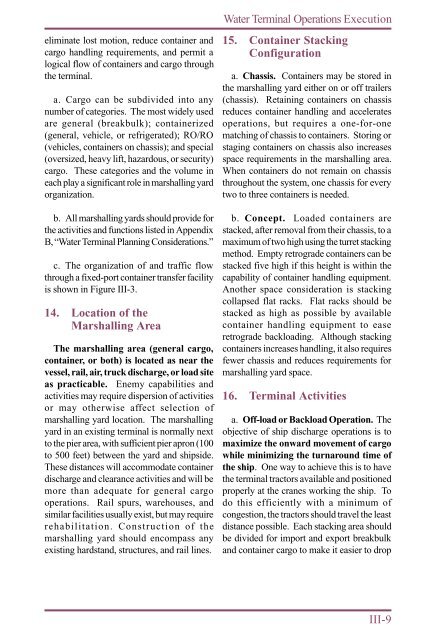JP 4-01.5 JTTP for Water Terminal Operations - BITS
JP 4-01.5 JTTP for Water Terminal Operations - BITS
JP 4-01.5 JTTP for Water Terminal Operations - BITS
Create successful ePaper yourself
Turn your PDF publications into a flip-book with our unique Google optimized e-Paper software.
eliminate lost motion, reduce container and<br />
cargo handling requirements, and permit a<br />
logical flow of containers and cargo through<br />
the terminal.<br />
a. Cargo can be subdivided into any<br />
number of categories. The most widely used<br />
are general (breakbulk); containerized<br />
(general, vehicle, or refrigerated); RO/RO<br />
(vehicles, containers on chassis); and special<br />
(oversized, heavy lift, hazardous, or security)<br />
cargo. These categories and the volume in<br />
each play a significant role in marshalling yard<br />
organization.<br />
b. All marshalling yards should provide <strong>for</strong><br />
the activities and functions listed in Appendix<br />
B, “<strong>Water</strong> <strong>Terminal</strong> Planning Considerations.”<br />
c. The organization of and traffic flow<br />
through a fixed-port container transfer facility<br />
is shown in Figure III-3.<br />
14. Location of the<br />
Marshalling Area<br />
The marshalling area (general cargo,<br />
container, or both) is located as near the<br />
vessel, rail, air, truck discharge, or load site<br />
as practicable. Enemy capabilities and<br />
activities may require dispersion of activities<br />
or may otherwise affect selection of<br />
marshalling yard location. The marshalling<br />
yard in an existing terminal is normally next<br />
to the pier area, with sufficient pier apron (100<br />
to 500 feet) between the yard and shipside.<br />
These distances will accommodate container<br />
discharge and clearance activities and will be<br />
more than adequate <strong>for</strong> general cargo<br />
operations. Rail spurs, warehouses, and<br />
similar facilities usually exist, but may require<br />
rehabilitation. Construction of the<br />
marshalling yard should encompass any<br />
existing hardstand, structures, and rail lines.<br />
<strong>Water</strong> <strong>Terminal</strong> <strong>Operations</strong> Execution<br />
15. Container Stacking<br />
Configuration<br />
a. Chassis. Containers may be stored in<br />
the marshalling yard either on or off trailers<br />
(chassis). Retaining containers on chassis<br />
reduces container handling and accelerates<br />
operations, but requires a one-<strong>for</strong>-one<br />
matching of chassis to containers. Storing or<br />
staging containers on chassis also increases<br />
space requirements in the marshalling area.<br />
When containers do not remain on chassis<br />
throughout the system, one chassis <strong>for</strong> every<br />
two to three containers is needed.<br />
b. Concept. Loaded containers are<br />
stacked, after removal from their chassis, to a<br />
maximum of two high using the turret stacking<br />
method. Empty retrograde containers can be<br />
stacked five high if this height is within the<br />
capability of container handling equipment.<br />
Another space consideration is stacking<br />
collapsed flat racks. Flat racks should be<br />
stacked as high as possible by available<br />
container handling equipment to ease<br />
retrograde backloading. Although stacking<br />
containers increases handling, it also requires<br />
fewer chassis and reduces requirements <strong>for</strong><br />
marshalling yard space.<br />
16. <strong>Terminal</strong> Activities<br />
a. Off-load or Backload Operation. The<br />
objective of ship discharge operations is to<br />
maximize the onward movement of cargo<br />
while minimizing the turnaround time of<br />
the ship. One way to achieve this is to have<br />
the terminal tractors available and positioned<br />
properly at the cranes working the ship. To<br />
do this efficiently with a minimum of<br />
congestion, the tractors should travel the least<br />
distance possible. Each stacking area should<br />
be divided <strong>for</strong> import and export breakbulk<br />
and container cargo to make it easier to drop<br />
III-9
















